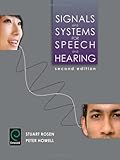Signals and systems for speech and hearing / by Stuart Rosen and Peter Howell.
Material type: TextPublication details: Bingley : Emerald, 2011.Edition: 2nd edDescription: xvii, 364 p. : ill. ; 25 cmISBN:
TextPublication details: Bingley : Emerald, 2011.Edition: 2nd edDescription: xvii, 364 p. : ill. ; 25 cmISBN: - 9781848552265 (pbk.) :
- 9781848552265 (pbk.) :
- 617.8 ROS
- QP306
| Item type | Current library | Call number | Copy number | Status | Date due | Barcode | |
|---|---|---|---|---|---|---|---|
| Long Loan | TUS: Midlands, Main Library Athlone Nursing Collection | 617.8 ROS (Browse shelf(Opens below)) | 1 | Available | 217323 |
Previous ed.: S.l.: Academic, 1991.
Previous ed.: Amsterdam; London: Elsevier Butterworth-Heinemann, 2005.
Formerly CIP. Uk
Includes bibliographical references and index.
darkness of a trace--Converting the time dimension into the x-axis on a piece of paper--Sections: short-term spectra--The choice of filter bandwidth--Determining a spectrum with filter banks of wide- and narrow-band filters--Resolving two spectral components close in frequency--Wide- and narrow-band spectrograms of an impulse--Resolving two pulses close in time--Wide- and narrow-band spectrograms of quasi-periodic pulse trains--Wide- and narrow-band spectrograms of random signals--Making spectrograms in the time domain--Dividing up a signal into sections--The choice of window length--Analyzing a sinusoid with different window lengths--Long- and short-time spectrograms of two closely spaced sinusoids--Long- and short-time spectrograms of a filtered periodic pulse train--Frequency equalization--Concludinmg remarks--Exercises--12. Applications to hearing:- Outer ear--Middle ear--The movement of the basilar--Membrane--Transduction by the inner hair cells--Making an auditory spectrogram--Exercises--13. Application to Speech Production:- Source-filter theory of speech production--Amplitude spectrum off /a / at a constant voice fundamental frequency--Amplitude spectrum /a / at a different voice fundamental frequency--Spectrographic representation of /a/ at different voice fundamental frequencies--Spectographs analysis of vowels with a changing fundamental--Properties of other vowel sounds--Diphthongal vowels--Voiceless fricatives--Summary and comments--Exercises--14. An Introduction to Digital Signals and Systems:- Pros and cons of digital techniques--What is an analogue signal?--What is a digital signal?--Digital systems--Quantization--Sampling--How does sampling have to be? The sampling theorem--Sampling complex signals--Processing the digital signal--Reconverting back to analogue form--A digital amplifier--A simple digital low-pass filter--A simple digital high-pass filter--A simple infinite impulse response system--FIR and IIR systems--Concluding remarks--Exercises.
1. Introduction: Exercises--2. Signals in the Real World:- The movement of a tuning fork--What is sound?--Converting pressure changes into a more convenient form--Getting back to acoustic signals--Summary--Exercises --3. Introduction to Signals:- Frequency and period of sinusoids--Constructing sinusoids--Using trigonometry to determine the shape of a sinusoid--Phase--Amplitude--Examples of other periodic signals--Aperiodic signals--Peak-to-peak and root-mean-square amplitude measurements--Measuring amplitude - the relationship between amplitude and intensity--Defining scales--Definition of the intensity scale -dB values--Scale reference points--Taking the logarithm of the ratio--Further features of dB scale--Exercise--Appendix: Exponents and logarithms ( to the base of 10) --4. Introduction to Systems:- Homogeneity--Additivity--Linearity = homogeneity + additivity--Time invariance--Exercises --5. A Preview:- Exercises--6. The Frequency Response of Systems:- Amplitude responses - the basic concept--Amplitude responses as ratios--Filters--Systems in parallel--Systems in cascade--Band-pass filters--Bqand-pass responses in simple physical systems--The amplitude response of a cascade of LTI systems--The vocal tract as a linear system--Phase responses--Linear phase responses--Wrapped and unwrapped phase curves--Other phase responses--The phase response of two LTI systems in cascade--The transfer function of LTI systems in cascade--Exercises--7. The Frequency Characterization of Signals:- Adding sinusoids: synthesis--Decomposing periodic waveforms: analysis--The Fourier series of a sawtooth waveform--Amplitude spectrum of a sawtooth wave--Phase spectrum of a sawtooth waveform--The effect of altering the phase of one component--The effect of altering the amplitude of one component--The effect of missing one component out--Spectra of other periodic waveforms--The spectrum of a pulse train--The effect of increasing period with the same duration pulse--Apectra of aperiodic signs--Fourier transform of a transient signal--Random signals--Exercises--8. Signals Through Systems:- Putting a periodic signal through a filter--Speeding things up--Putting a periodic signal through a real low-pass filter--Putting an aperiodic signal through a system--Distortation and the perfect system--Exercises--9. The Time Characterization of Systems:- What can we learn from a system response to a single pulse?--Approximating signals with rectangular pulses--The relationship between the impulse response and the frequency response--Determining the frequency response of a system: a practical example--Exercises--10. The Relationship Between the Time and Frequency Domains:- The spectra of rectangular pulses of varying duration--The spectra of sinusoids of varying duration--\'Windowing\' signals--\'Windowing\' non-sinusoidal signals--The relationship between the ordinary and inverse Fourier transform--Time domain and frequency domain relationships for systems--The impulse and amplitude response of simple band-pass filters--Resolution in frequency for different bandwidths--Resolution in time for different bandwidths--Bandwidth versus resolution: a summary--Exercises--11. The Spectrogram:- The basic problem: determining the spectra of real-life signals--Analyzing a sawtooth with a filter bank--Signals that change in time--Whistling through a single band-pass filter--Getting rid of detail: rectification and smoothing--Summary: filtering, rectification and smoothing--Looking across a range of frequencies with a filter bank--Constructing a spectrogram--Displaying spectrograms in a convenient way--Spectographs--Another approach to making a spectrogram--The graphic equalizer--A spectrum displayed as a bar graph--Converting the height of a bar into the da
This text is an introduction to the concepts of signals and systems analysis that play a role in the speech and hearing sciences, using only minimal mathematics.
